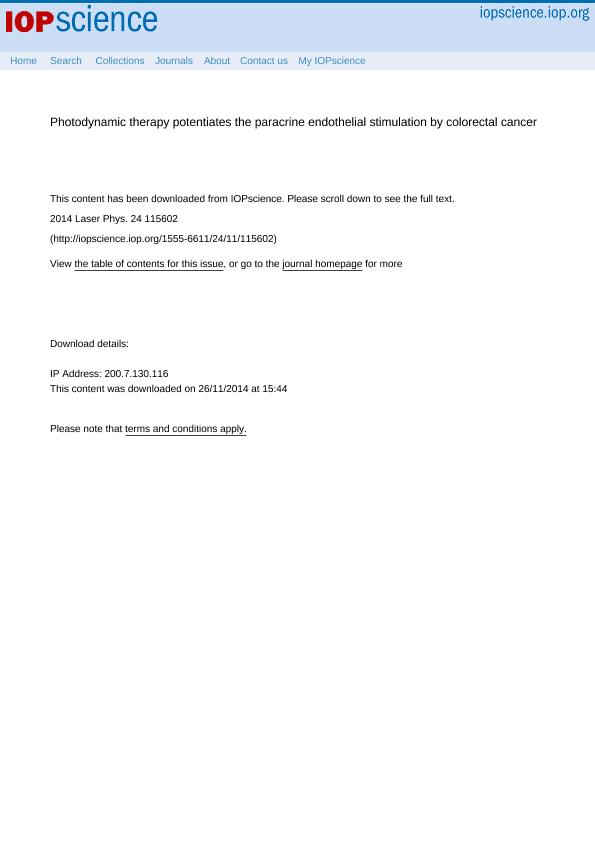Mostrar el registro sencillo del ítem
dc.contributor.author
Lamberti, María Julia

dc.contributor.author
Pansa, Maria Florencia

dc.contributor.author
Vera, Renzo Emanuel

dc.contributor.author
Rumie Vittar, Natalia Belen

dc.contributor.author
Rivarola, Viviana

dc.date.available
2018-04-23T17:00:21Z
dc.date.issued
2014-10
dc.identifier.citation
Lamberti, María Julia; Pansa, Maria Florencia; Vera, Renzo Emanuel; Rumie Vittar, Natalia Belen; Rivarola, Viviana; Photodynamic therapy potentiates the paracrine endothelial stimulation by colorectal cancer; IOP Publishing; Laser Physics; 24; 11; 10-2014; 1-8; 115602
dc.identifier.issn
1054-660X
dc.identifier.uri
http://hdl.handle.net/11336/43029
dc.description.abstract
Colorectal cancer (CRC) is the third most common cancer and the third leading cause of cancer death worldwide. Recurrence is a major problem and is often the ultimate cause of death. In this context, the tumor microenvironment influences tumor progression and is considered as a new essential feature that clearly impacts on treatment outcome, and must therefore be taken into consideration. Photodynamic therapy (PDT), oxygen, light and drug-dependent, is a novel treatment modality when CRC patients are inoperable. Tumor vasculature and parenchyma cells are both potential targets of PDT damage modulating tumor–stroma interactions. In biological activity assessment in photodynamic research, three-dimensional (3D) cultures are essential to integrate biomechanical, biochemical, and biophysical properties that better predict the outcome of oxygen- and drug-dependent medical therapies. Therefore, the objective of this study was to investigate the antitumor effect of methyl 5-aminolevulinic acid-PDT using a light emitting diode for the treatment of CRC cells in a scenario that mimics targeted tissue complexity, providing a potential bridge for the gap between 2D cultures and animal models. Since photodynamic intervention of the tumor microenvironment can effectively modulate the tumor–stroma interaction, it was proposed to characterize the endothelial response to CRC paracrine communication, if one of these two populations is photosensitized. In conclusion, we demonstrated that the dialogue between endothelial and tumor populations when subjected to lethal PDT conditions induces an increase in angiogenic phenotype, and we think that it should be carefully considered for the development of PDT therapeutic protocols.
dc.format
application/pdf
dc.language.iso
eng
dc.publisher
IOP Publishing

dc.rights
info:eu-repo/semantics/openAccess
dc.rights.uri
https://creativecommons.org/licenses/by-nc-sa/2.5/ar/
dc.subject
Photodynamic Therapy
dc.subject
Colorectal Cancer
dc.subject
Tumor Microenvironment
dc.subject
Angiogenesis
dc.subject
3d Culture
dc.subject.classification
Otras Ciencias Biológicas

dc.subject.classification
Ciencias Biológicas

dc.subject.classification
CIENCIAS NATURALES Y EXACTAS

dc.title
Photodynamic therapy potentiates the paracrine endothelial stimulation by colorectal cancer
dc.type
info:eu-repo/semantics/article
dc.type
info:ar-repo/semantics/artículo
dc.type
info:eu-repo/semantics/publishedVersion
dc.date.updated
2018-03-02T14:09:39Z
dc.journal.volume
24
dc.journal.number
11
dc.journal.pagination
1-8; 115602
dc.journal.pais
Reino Unido

dc.description.fil
Fil: Lamberti, María Julia. Universidad Nacional de Río Cuarto. Facultad de Ciencias Exactas, Fisicoquímicas y Naturales. Departamento de Biología Molecular. Sección Química Biológica; Argentina. Consejo Nacional de Investigaciones Científicas y Técnicas; Argentina
dc.description.fil
Fil: Pansa, Maria Florencia. Universidad Nacional de Río Cuarto. Facultad de Ciencias Exactas, Fisicoquímicas y Naturales. Departamento de Biología Molecular. Sección Química Biológica; Argentina. Consejo Nacional de Investigaciones Científicas y Técnicas; Argentina
dc.description.fil
Fil: Vera, Renzo Emanuel. Universidad Nacional de Río Cuarto. Facultad de Ciencias Exactas, Fisicoquímicas y Naturales. Departamento de Biología Molecular. Sección Química Biológica; Argentina. Consejo Nacional de Investigaciones Científicas y Técnicas; Argentina
dc.description.fil
Fil: Rumie Vittar, Natalia Belen. Universidad Nacional de Río Cuarto. Facultad de Ciencias Exactas, Fisicoquímicas y Naturales. Departamento de Biología Molecular. Sección Química Biológica; Argentina. Consejo Nacional de Investigaciones Científicas y Técnicas; Argentina
dc.description.fil
Fil: Rivarola, Viviana. Universidad Nacional de Río Cuarto. Facultad de Ciencias Exactas, Fisicoquímicas y Naturales. Departamento de Biología Molecular. Sección Química Biológica; Argentina. Consejo Nacional de Investigaciones Científicas y Técnicas; Argentina
dc.journal.title
Laser Physics

dc.relation.alternativeid
info:eu-repo/semantics/altIdentifier/doi/http://dx.doi.org/10.1088/1054-660X/24/11/115602
dc.relation.alternativeid
info:eu-repo/semantics/altIdentifier/url/http://iopscience.iop.org/article/10.1088/1054-660X/24/11/115602
Archivos asociados
